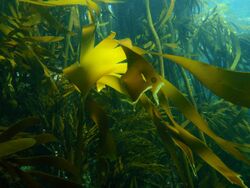Biology:Ochrophyta
| Ochrophyta | |
|---|---|

| |
| Dense kelp forest with understory at Partridge Point near Dave's Caves, Cape Peninsula | |
| Scientific classification | |
| Domain: | Eukaryota |
| Clade: | Diaphoretickes |
| Clade: | SAR |
| Clade: | Stramenopiles |
| Phylum: | Gyrista |
| Subphylum: | Ochrophytina |
| Classes | |
| Synonyms | |
| |
Ochrophyta is a group of mostly photosynthetic heterokonts.[4][5] Their plastid is of red algal origin.[6]
The classification of the group is still being worked out. Some authors (e.g., Cavalier-Smith) divide it into two subphyla, Phaeista Cavalier-Smith 1995 (comprising Hypogyristea and Chrysista in some classifications, or Limnista and Marista in others) and Khakista Cavalier-Smith, 2000 (comprising Bolidomonas and diatoms).[7] Others prefer not to use the subphyla, listing only lower taxa (e.g., Reviers, 2002, Guiry & Guiry, 2014).[citation needed]
Phylogeny
Based on the work of Ruggiero et al. (2015)[8] and on Silar (2016).[9]
| Ochrophyta |
| ||||||||||||||||||||||||||||||||||||||||||||||||||||||||||||||||||||||||||||||||||||
References
- ↑ Cavalier-Smith, T. (1986). The kingdom Chromista, origin and systematics. In: Round, F.E. and Chapman, D.J. (eds.). Progress in Phycological Research. 4: 309–347.
- ↑ Reviers, B. de. (2006). Biologia e Filogenia das Algas. Editora Artmed, Porto Alegre, p. 157.
- ↑ Reviers, B. de. (2006). Biologia e Filogenia das Algas. Editora Artmed, Porto Alegre, pp. 15-16.
- ↑ Thomas Cavalier-Smith; Ema E.-Y. Chao (2006). "Phylogeny and megasystematics of phagotrophic heterokonts (kingdom Chromista)". Journal of Molecular Evolution 62 (4): 388–420. doi:10.1007/s00239-004-0353-8. PMID 16557340. Bibcode: 2006JMolE..62..388C.
- ↑ Ingvild Riisberga; Russell J. S. Orr; Ragnhild Kluge; Kamran Shalchian-Tabrizi; Holly A. Bowers; Vishwanath Patil; Bente Edvardsen; Kjetill S. Jakobsen (2009). "Seven gene phylogeny of heterokonts". Protist 160 (2): 191–204. doi:10.1016/j.protis.2008.11.004. PMID 19213601.
- ↑ Updating algal evolutionary relationships through plastid genome sequencing: did alveolate plastids emerge through endosymbiosis of an ochrophyte?
- ↑ "Heterokontophyta". SHIGEN. National Institute of Genetics. http://www.shigen.nig.ac.jp/algae_tree/HeterokontophytaE.html.
- ↑ Ruggiero, Michael A. (2015). "Higher level classification of all living organisms". PLoS One 10 (4): e0119248. doi:10.1371/journal.pone.0119248. PMID 25923521. Bibcode: 2015PLoSO..1019248R.
- ↑ Silar, Philippe (2016). "Protistes eucaryotes: Origine, evolution et biologie des microbes eucaryotes". Université Paris Cité. pp. 1–462. https://hal.archives-ouvertes.fr/hal-01263138.
Wikidata ☰ Q1048772 entry

